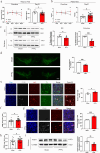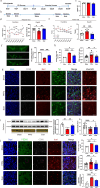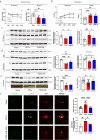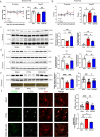Exercise training upregulates CD55 to suppress complement-mediated synaptic phagocytosis in Parkinson's disease
- PMID: 39342308
- PMCID: PMC11439226
- DOI: 10.1186/s12974-024-03234-0
Exercise training upregulates CD55 to suppress complement-mediated synaptic phagocytosis in Parkinson's disease
Abstract
The primary pathological change in Parkinson's disease (PD) is the progressive degeneration of dopaminergic neurons in the substantia nigra. Additionally, excessive microglial activation and synaptic loss are also typical features observed in PD samples. Exercise trainings have been proven to improve PD symptoms, delay the disease progression as well as affect excessive microglial synaptic phagocytosis. In this study, we established a mouse model of PD by injecting mouse-derived α-synuclein preformed fibrils (M-α-syn PFFs) into the substantia nigra, and demonstrated that treadmill exercise inhibits microglial activation and synaptic phagocytosis in striatum. Using RNA-Seq and proteomics, we also found that PD involves excessive activation of the complement pathway which is closely related to over-activation of microglia and abnormal synaptic function. More importantly, exercise training can inhibit complement levels and complement-mediated microglial phagocytosis of synapses. It is probably triggered by CD55, as we observed that CD55 in the striatum significantly increased after exercise training and up-regulation of that molecule rescued motor deficits of PD mice, accompanied with reduced microglial synaptic phagocytosis in the striatum. This research elucidated the interplay among microglia, complement, and synapses, and analyzed the effects of exercise training on these factors. Our work also suggested CD55 as a complement-relevant candidate molecule for developing therapeutic strategies of PD.
Keywords: CD55; Complement pathway; Microglia; Parkinson’s disease; Proteomics and RNA-seq analysis; Synapses.
© 2024. The Author(s).
Conflict of interest statement
The authors declare no competing interests.
Figures







Similar articles
-
TREM2 signaling in Parkinson's disease: Regulation of microglial function and α-synuclein pathology.Int Immunopharmacol. 2024 Dec 25;143(Pt 2):113446. doi: 10.1016/j.intimp.2024.113446. Epub 2024 Oct 29. Int Immunopharmacol. 2024. PMID: 39490141
-
Microglia affect α-synuclein cell-to-cell transfer in a mouse model of Parkinson's disease.Mol Neurodegener. 2019 Aug 16;14(1):34. doi: 10.1186/s13024-019-0335-3. Mol Neurodegener. 2019. PMID: 31419995 Free PMC article.
-
Further Characterization of Intrastriatal Lipopolysaccharide Model of Parkinson's Disease in C57BL/6 Mice.Int J Mol Sci. 2021 Jul 9;22(14):7380. doi: 10.3390/ijms22147380. Int J Mol Sci. 2021. PMID: 34299000 Free PMC article.
-
Pathological α-synuclein exacerbates the progression of Parkinson's disease through microglial activation.Toxicol Lett. 2017 Jan 4;265:30-37. doi: 10.1016/j.toxlet.2016.11.002. Epub 2016 Nov 16. Toxicol Lett. 2017. PMID: 27865851 Review.
-
Targeting Microglial α-Synuclein/TLRs/NF-kappaB/NLRP3 Inflammasome Axis in Parkinson's Disease.Front Immunol. 2021 Oct 8;12:719807. doi: 10.3389/fimmu.2021.719807. eCollection 2021. Front Immunol. 2021. PMID: 34691027 Free PMC article. Review.
Cited by
-
Multiomics Integration of Parkinson's Disease Datasets Reveals Unexpected Roles of IRE1 in Its Pathology.Int J Mol Sci. 2025 Jul 12;26(14):6711. doi: 10.3390/ijms26146711. Int J Mol Sci. 2025. PMID: 40724959 Free PMC article.
-
A Comprehensive Study of Circulating Blood Linear RNA nominates CD55 and DLD as novel causal genes and early-stage biomarkers for Parkinson's Disease.medRxiv [Preprint]. 2025 Jun 20:2025.06.20.25329948. doi: 10.1101/2025.06.20.25329948. medRxiv. 2025. PMID: 40585127 Free PMC article. Preprint.
-
New perspectives on molecular mechanisms underlying exercise-induced benefits in Parkinson's disease.NPJ Parkinsons Dis. 2025 Aug 23;11(1):256. doi: 10.1038/s41531-025-01113-w. NPJ Parkinsons Dis. 2025. PMID: 40849310 Free PMC article. Review.
References
-
- Olanow CW, Tatton WG. Etiology and pathogenesis of Parkinson’s disease. Annu Rev Neurosci. 1999;22:123–44. - PubMed
-
- Samii A, Nutt JG, Ransom BR. Parkinson’s disease. Lancet. 2004;363(9423):1783–93. - PubMed
-
- Hayes MT. Parkinson’s disease and parkinsonism. Am J Med. 2019;132(7):802–7. - PubMed
-
- Lees AJ, Hardy J, Revesz T. Parkinson’s disease. Lancet. 2009;373(9680):2055–66. - PubMed
MeSH terms
Substances
Grants and funding
LinkOut - more resources
Full Text Sources
Medical
Miscellaneous

